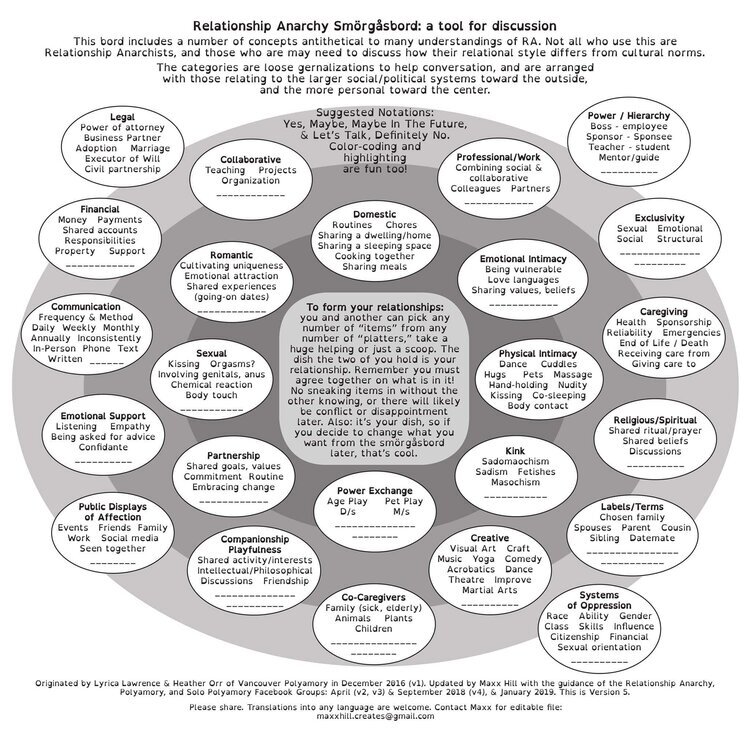Relationship anarchy seeks to redefine identity and relationships with a radical paradigm based on anarchy.
Are you polyamorous in nature but don’t identify with hierarchical polyamory, while at the same time feel non-hierarchical polyamory isn’t quite a fit either?
There’s a whole philosophy and practice of polyamory called relationship anarchy. It is non-hierarchical, but in a way, it views non-hierarchical polyamory as too political. Relationship anarchy is political too but to the extent that anarchy itself is political—it rejects politics, norms, and traditional social values.
Read: Hierarchical Polyamory vs Non-Hierarchical Polyamory
What Is Relationship Anarchy?
When you hear the word “anarchy,” you might think about chaos and disorder—a world without rules. Alternately, you might think of a kind of utopia—a society of free people doing what they want without the boot of the government making their choices for them.
By definition, both of these are right: anarchy is “the absence of government” and depending on who interprets that fact, a utopia or a lawless disorder results.
All of these are parallel definitions of the word anarchy, according to Merriam-Webster Dictionary. “The absence of or denial of any authority or established order.”
Anarchy rejects the church, the state, and any authority, and places autonomy and freedom in every individual’s hands. Depending on who you ask, or who is practicing, chaos can erupt, or a state of nirvana and liberation.
Relationship anarchy is a philosophy or belief that applies the tenets of anarchy to relationships. It rejects state control or intervention of relationships, rejects religious dictates, and rejects all rules and social and cultural customs, hierarchies and norms.
Relationship anarchy rejects structures of any kind. It values individual autonomy, diverse non-hierarchical relationships, and the absence of authority, including state authority, gender authority, religious authority, and cultural authority. Relationship anarchy values community interdependence.
While relationship anarchy may seem like a parallel for non-hierarchical polyamory, especially solo polyamory, there is a difference. Relationship anarchy does not prioritize ANY relationship. While non-hierarchical polyamory rejects the hierarchies of couples, primary partnerships, and marriage, and sees all lovers as equal, relationship polyamory views all relationships as equal, including non-sexual relationships. A lover and friend and doctor and postal worker and sister and uncle are all interconnected relationships.
A lover does not have special or specific value over a friendship and a parent does not have unique authority or unique bonds. Relationship anarchy could be seen as “beyond romantic love.” It is less about having multiple, equal hierarchical or non-hierarchical lovers, less focused on who has sex with whom, and more interested in romance and sexuality being incidental aspects of some relationships, with all relationships being valued on their own terms.
Relationship anarchy may seem like the new kid on the block, but as long as philosophical anarchy has existed, it has been a thing. Ten years ago, the term relationship anarchy was popularized by Andie Nordgren in a blog essay that she translated from her native Swedish, Relationsanarki i 8 punkter, or “Relationship Anarchy in Eight Points.”
Before this pivotal moment, there were always folks who lived on their own terms and rejected social and cultural rules for how they lived and loved.
Read: The Short Instructional Manifesto for Relationship Anarchy
Values of Relationship Anarchy
1. Love is abundant, and every relationship is unique.
Relationships on your own terms is exactly what Nordgren suggests. Love is not a finite resource. The first value she describes is that “love is abundant, and every relationship is unique.” Nordgren suggests you “customize your commitments,” and design your own relationships based on what you want, rather than ranking relationships the way society or the state or other authorities expect.
2. Love and respect instead of entitlement.
Relationship anarchy is about respecting every person’s autonomy. You do not control a person or expect their compliance and compromise, and vice versa.
Read: Commitment vs Containment in Poly Relationships
3. Find your core set of relationship values.
Consider for yourself how you want to be treated by others and what your boundaries are. Every person chooses who they want to spend their time with and how they want to spend it. The principles and values apply equally to one’s relationships.
4. Reject heterosexism, and reject fear.
Societies are built on powerful “normative systems” that attempt to define love. But every individual should define relationships for themselves. Reject the fear that might guide your choices, and follow your heart and personal needs.
5. Fake it til’ you make it.
Nordgren acknowledges that the plunge into relationship anarchy can be stressful because breaking norms has blowback. Don’t give in to the pressures, and live your life. If it is hard at first, stick with it by envisioning how you want things to be and acting out that life.
6. Trust.
It is radical to trust. Nordgren says that “choosing to assume that your partner does not wish to harm you” is a more positive path and helps create the kind of relationships that work.
Read: 10 Ways to Build Trust in a Relationship
7. Communication.
“Communicate in a context of trust.” The only way into radical relationships is to be open and communicate, not just when there is a problem to solve but before that.
Read: Tips for Maintaining Communication in Poly Relationships
8. Customize your commitments.
Rather than hierarchies, customize the relationships you want from scratch. Design family, friendships, and romance according to your own rules.
The Relationship Anarchy Smorgasbord

Relationship anarchists have a wonderful tool that helps construct unique relationships. The concept of a relationship as a plate that can be filled with a variety of qualities, circumstances, and activities helps design each relationship according to personal desires rather than social norms.
The relationship anarchy smorgasbord illustrations offer ideas for a buffet where each relationship can pick out what they want and “put it on their plate.” Sometimes a “yes, no, maybe” system is helpful to construct the relationship.
There is no official smorgasbord. The smorgasbord chart originated by Lyrica Lawrence and Heather Orr of Vancouver Polyamory is very useful, but there are different versions (see version 5 above), and individuals can design their own on paper or mentally. Some of the buffet items include communication frequency, finance, sexuality, domestic responsibilities, caregiving, labels, creativity, and kink.
Relationship anarchy is an evolving philosophy and radical perspective on life that can redefine traditional relationships in a positive way.
Do you practice relationship anarchy? Share your ideas and resources in the comments.

Tell us what you think